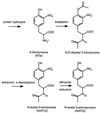Inflammation and NO(X)-induced nitration: assay for 3-nitrotyrosine by HPLC with electrochemical detection
- PMID: 9096372
- PMCID: PMC20348
- DOI: 10.1073/pnas.94.7.3211
Inflammation and NO(X)-induced nitration: assay for 3-nitrotyrosine by HPLC with electrochemical detection
Abstract
The identification of 15N-labeled 3-nitrotyrosine (NTyr) by gas chromatography/mass spectroscopy in protein hydrolyzates from activated RAW 264.7 macrophages incubated with 15N-L-arginine confirms that nitric oxide synthase (NOS) is involved in the nitration of protein-bound tyrosine (Tyr). An assay is presented for NTyr that employs HPLC with tandem electrochemical and UV detection. The assay involves enzymatic hydrolysis of protein, acetylation, solvent extraction, O-deacetylation, and dithionite reduction to produce an analyte containing N-acetyl-3-aminotyrosine, an electrochemically active derivative of NTyr. We estimate the level of protein-bound NTyr in normal rat plasma to be approximately 0-1 residues per 10(6) Tyr with a detection limit of 0.5 per 10(7) Tyr when > 100 nmol of Tyr is analyzed and when precautions are taken to limit nitration artifacts. Zymosan-treated RAW 264.7 cells were shown to have an approximately 6-fold higher level of protein-bound NTyr compared with control cells and cells treated with N(G)-monomethyl-L-arginine, an inhibitor of NOS. Intraperitoneal injection of F344 rats with zymosan led to a marked elevation in protein-bound NTyr to approximately 13 residues per 10(6) Tyr, an approximately 40-fold elevation compared with plasma protein of untreated rats; cotreatment with N(G)-monomethyl-L-arginine inhibited the formation of NTyr in plasma protein from blood and peritoneal exudate by 69% and 53%, respectively. This assay offers a highly sensitive and quantitative approach for investigating the role of reactive byproducts of nitric oxide in the many pathological conditions and disease states associated with NO(X) exposure such as inflammation and smoking.
Figures



References
-
- Huie R E, Padmaja S. Free Radical Res Commun. 1993;18:195–199. - PubMed
-
- Ischiropoulos H, Zhu L, Beckman J S. Arch Biochem Biophys. 1992;298:446–451. - PubMed
-
- Radi R, Beckman J S, Bush K M, Freeman B A. Arch Biochem Biophys. 1991;288:481–487. - PubMed
-
- Douki T, Cadet J, Ames B N. Chem Res Toxicol. 1996;9:3–7. - PubMed
-
- Yermilov V, Rubio J, Becchi M, Friesen M D, Pignatelli B, Ohshima H. Carcinogenesis. 1995;16:2045–2050. - PubMed
Publication types
MeSH terms
Substances
Grants and funding
LinkOut - more resources
Full Text Sources
Other Literature Sources

